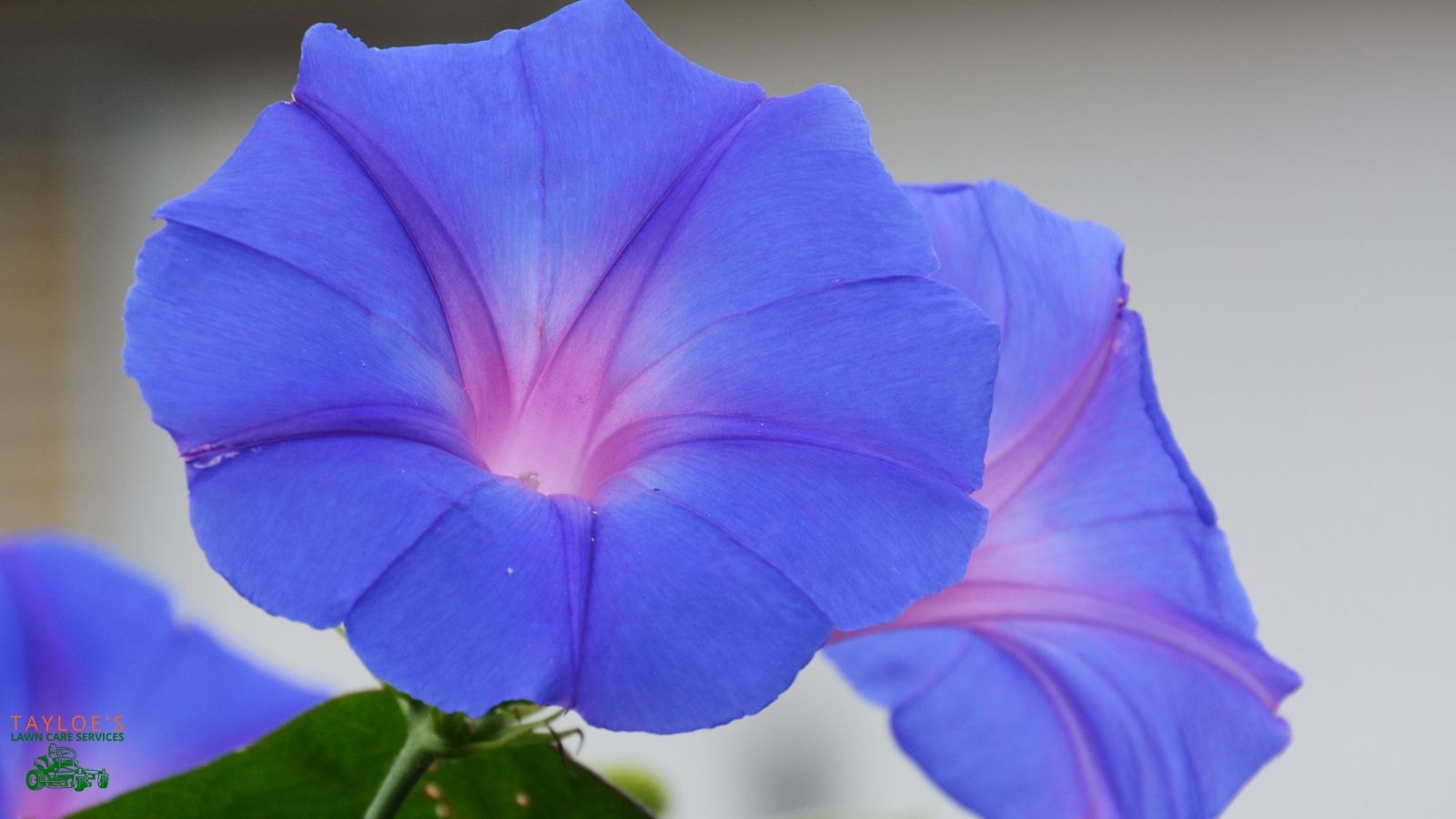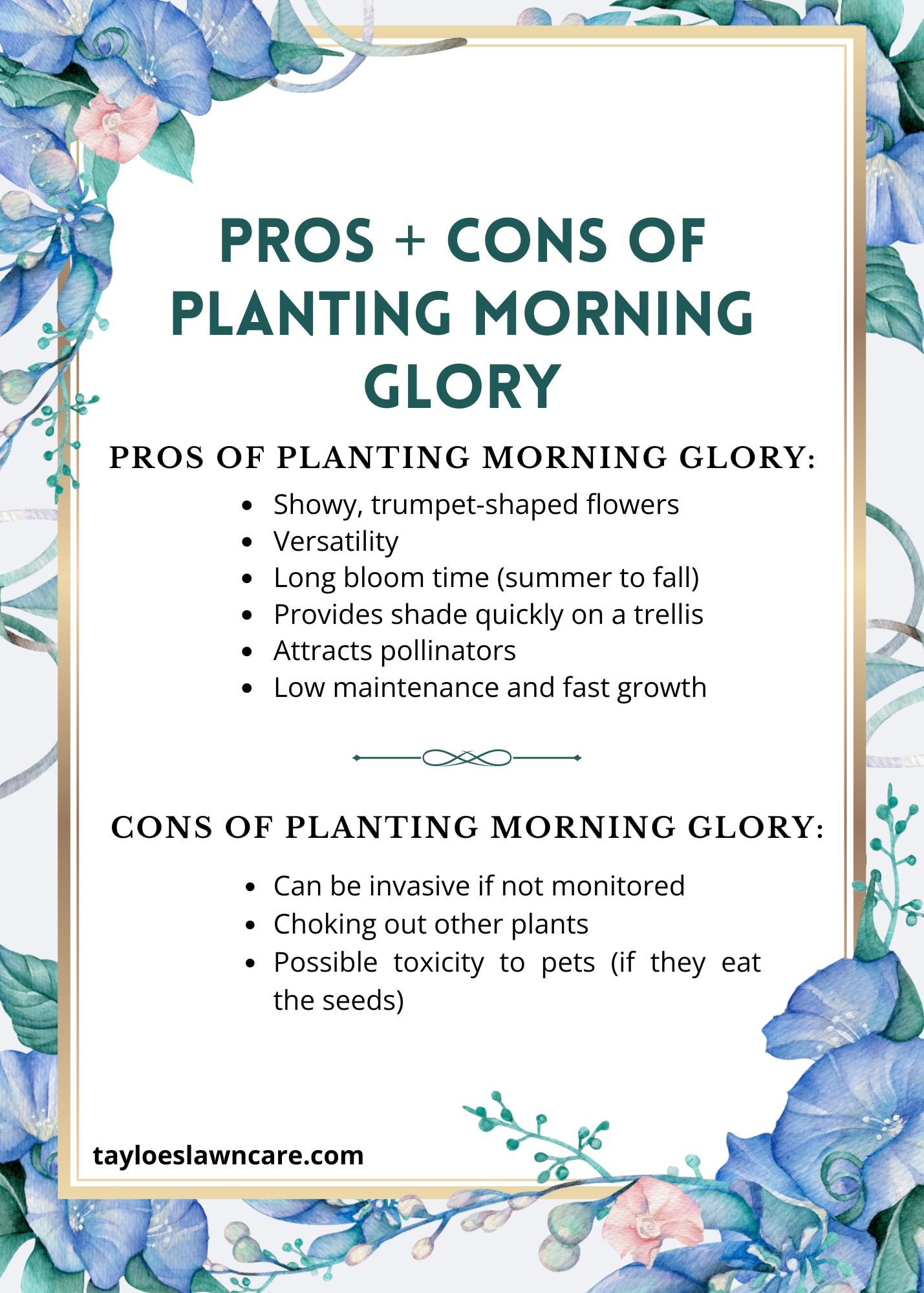Last Updated on: 8th August 2024, 01:27 pm

Are heavenly blue morning glory flowers a beauty to behold or invasive plants?
With their vibrant, trumpet-shaped flowers and rapid growth, morning glories have long been a debate among gardeners. Are they a noxious weed or a beautiful climbing vine that adds charm to any garden?
This blog post explores the pros and cons of planting morning glory plants, providing essential facts and insights to help you make an informed decision before you plant them.
Basic Facts about Morning Glories
Here are the facts you should know before you plant morning glory seeds in your garden.
Scientific Name and Family
Morning glories belong to the genus Ipomoea in the family Convolvulaceae. The most common species is Ipomoea purpurea, known for its striking blue, pink, purple, and white flowers, usually blue flowers with a white throat.
Morning Glory Flower and USDA Growing Zones
Morning glory plants thrive in USDA hardiness zones 3 to 10. This broad range makes them versatile for many gardeners from warmer to colder climates. They are a South and Central America native species, but they’re well adapted to thrive in most of the United States
Description and Growth Habits of Common Morning Glory Varieties
Morning glories are annual or perennial species that can grow up to 15 feet or more in one season. They have heart-shaped leaves and twining stems that allow them to climb trellises, fences, and other structures.
Some folks call them “railroad vine,” as they grow randomly along the tracks without help from gardeners.
The flowers typically open in the morning and close by the afternoon, hence their name.
In what zones can the morning glory be annuals, and in what zones are they perennials?
Morning glories can be both annuals and perennials depending on the USDA hardiness zones:
Annuals: In USDA hardiness zones 3 to 8, morning glories are typically grown as annuals. They complete their life cycle in one growing season and must be replanted yearly.
Perennials: Morning glories can be grown as perennials in USDA hardiness zones 9 to 11. They can survive year-round and regrowth each season without the need for replanting.
Understanding your area’s growing zone can help you determine whether morning glories will be an annual or perennial in your garden.
Pros of Planting Morning Glory Vines
Have you ever wondered why someone would plant morning glory seeds when they can take over so fast? Here are the reason so many gardeners adore them.
1. Aesthetic Appeal
Stunning Trumpet Shaped Flowers
One of the main attractions of morning glories is their beautiful, vibrant flowers. They can add a splash of color to any garden and create a visually appealing vertical display.
Versatility in Garden Design
Morning glory can be used in various garden designs. They are excellent for covering fences, arbors, and trellises, providing both beauty and privacy.
2. Easy to Grow
Minimal Maintenance
Morning glory is relatively easy to grow and require minimal maintenance. They thrive in well-drained soil and full sun, and they are quite drought-tolerant once established.
Fast Growth
Morning glory seeds grow quickly, making them an ideal choice for gardeners who want to see rapid results. They can quickly cover unsightly structures or fill in gaps in the garden.
3. Attract Pollinators
Morning glories attract pollinators such as bees, butterflies, and hummingbirds. This not only benefits the plants but also supports the local ecosystem by promoting pollination.
4. Provides Shade and Privacy
Morning glories can serve as a natural screen, providing shade and privacy in your garden. They give more foliage to block out unwanted views than slower-growing species.
Cooling Effect
The shade provided by the vine can also block the sun. Planting them near windows or patios can add beautiful shade.
Cons of Planting Morning Glory Seeds
Now that we have looked at the good reasons to welcome the morning glory flower to your garden, here are some reasons many avoid planting these flowering plants.
1. Invasive Nature
Because of their aggressive growth habits, morning glories can become invasive. They can grow rapidly and take over garden spaces, quickly crowding out other species and becoming difficult to control.
These vines produce many morning glory seeds, which self-seed easily and germinate in unwanted areas. This can lead to morning glories popping up throughout the garden and even in neighboring properties.
2. Potentially Harmful to Other Plants
Morning glories can compete with other plants for sunlight, water, and nutrients. Their rapid growth can overshadow other plants, inhibiting their growth and potentially leading to their demise.
The twining habit of morning glories can smother other flowers in the garden, particularly smaller or slower-growing ones. They can wrap around stems and leaves, causing physical damage and stress to other plants.
3. Toxicity Concerns (Humans and Pets)
Some species of morning glories contain toxic compounds, particularly in their hard seed coat. Ingesting these seeds can cause symptoms such as nausea, vomiting, and hallucinations in both humans and pets.

Popular Morning Glory Varieties
Morning glory species vary in color, although the heavenly blue and heirloom morning glory, with its lovely white throat, is the most widely known.
1. Ipomoea purpurea (Heirloom Morning Glory)
Flowers: Large, trumpet-shaped flowers in shades of blue, pink, purple, and white.
Leaves: Heart-shaped leaves.
Growth: Rapid climber, can reach up to 10-15 feet in one growing season.
Notes: This is the common morning glory you will easily recognize; it’s known for its vigorous growth and abundant flowering.
2. Ipomoea tricolor (Heavenly Blue Morning Glory)
Flowers: Large, vivid sky-blue flowers with yellow or white throats.
Leaves: Heart leaves.
Growth: Can grow up to 12 feet tall.
Notes: This variety is highly popular for its striking blue flowers and is often used in ornamental gardening.
3. Ipomoea nil (Japanese Morning Glory)
Flowers: Wide range of colors, including blue, pink, purple, white, or bright red flowers
Leaves: Varied leaf shapes, often lobed or deeply cut.
Growth: Vigorous climber, can reach 6-10 feet.
Notes: This species is particularly favored in Japan and is known for its diverse and ornamental flower patterns.
4. Ipomoea alba (Moonflower)
Flowers: Large, fragrant white flowers that open in the evening and close by morning.
Leaves: Broad, morning glory leaves.
Growth: Can grow up to 15 feet or more.
Notes: Unlike its close relative, the moonflower will bloom at night – a great choice for moon gardens and evening enjoyment.
5. Ipomoea quamoclit (Cypress Vine)
Flowers: Small, star-shaped red, pink, or white flowers.
Leaves: Fern-like, feathery foliage.
Growth: Can reach up to 20 feet.
Notes: This variety is notable for its delicate foliage and bright flowers, attracting hummingbirds and other pollinators.
6. Ipomoea lobata (Spanish Flag)
Flowers: Small, tubular flowers that start red and fade to orange, yellow, and white, giving a multi-colored effect.
Leaves: Deeply lobed, green leaves.
Growth: Can grow up to 10-15 feet.
Notes: Also known as the firecracker vine, this variety is admired for its striking and unusual flower colors.
7. Ipomoea batatas (Sweet Potato Vine)
Flowers: Smaller, less showy flowers in shades of pink to purple.
Leaves: Varied leaf shapes and colors, often used more for ornamental foliage.
Growth: Can spread extensively as a ground cover.
Notes: While primarily grown for its edible tubers, the sweet potato vine is also popular in ornamental gardening for its attractive foliage.
8. Ipomoea imperati (Beach Morning Glory)
Flowers: White with a yellow center.
Leaves: Long, narrow, and succulent.
Growth: Spreads horizontally, typically found in coastal areas.
Notes: This variety is highly tolerant of salt and sandy soils and is known for stabilizing sand dunes.
9. Convolvulus tricolor (Dwarf Morning Glory)
Flowers: Small, tri-colored flowers in shades of blue, pink, and white.
Leaves: Small, lance-shaped leaves.
Growth: Low-growing, typically only reaching 1-2 feet in height.
Notes: Ideal for ground cover, borders, or containers, this variety is known for its compact growth habit.
Ideal Growing Conditions to Start Morning Glory Seeds
Morning glories prefer to grow in conditions that support their vigorous and expansive nature. Remember that these are Central America imports.
Planting Time After the Last Frost Date
Morning glories should be planted after the last spring frost. This timing ensures that the young plants are not exposed to freezing temperatures, which can damage or kill them. Ideally, plant the seeds in early summer when the soil has warmed up and the danger of frost has passed.
Temperature and Light
These vines thrive in warm temperatures and require full sun to bloom profusely. Ensure they receive at least six hours of direct sunlight daily for optimal growth.
Soil Requirements
Morning glories prefer well-draining soil to prevent waterlogged roots. They’ll enjoy a balanced liquid fertilizer every few weeks. Keeping the soil moist is important, especially during the initial growth stages. Once established, they are drought-tolerant.
Watering and Root Care
When planting morning glory seeds, ensure they have enough space to develop deep roots. Regular watering keeps the soil moist -water deeply, but overwatering causes stem rot. During dry spells, particularly mid-summer, additional watering helps maintain their health and encourages flowering.
How to Manage Morning Glories in Your Garden
1. Controlled Planting When You Grow Morning Glory
To manage the invasive potential of your morning glory, plant them in controlled areas such as containers or isolated garden beds. This can help contain their spread and make them easier to manage.
Use Trellises and Supports
Using trellises or other supports can help direct the growth of your morning glory and prevent it from spreading uncontrollably. This method also makes it easier to prune and maintain the plants.
2. Regular Maintenance
Pruning and deadheading old flowers can help control morning glory growth.
Keep an eye on morning glory growth and take action if they start to encroach on your garden or lawn. Watch for new plants and remove them promptly.
3. Using Barriers
Using physical barriers such as garden edging or landscape fabric can help prevent the spread of morning glories. These barriers can restrict their roots and limit their ability to invade other areas.
4. Soil Management
Cover lightly with a layer of mulch around morning glories can help suppress the growth of unwanted seedlings. Mulch can also retain moisture during dry periods.
5. Chemical Control
In extreme cases, chemical control methods such as herbicides may be necessary to manage self-seeding morning glories. Always follow the manufacturer’s instructions and use these products responsibly.
The Takeaway: Common Morning Glory Vines Have Gorgeous Flowers but Should Be Planted With Great Care
Morning glories can be both a beautiful addition and a challenging invasive plant in the garden. Their stunning flowers and fast growth make them attractive, but their aggressive nature requires careful management. By controlling their growth, you can enjoy the beauty of morning glory and its long bloom time, from mid-summer to fall. Whether you view morning glories as an invasive weed or a beautiful climbing vine, the key is to manage them responsibly and enjoy the show.
Author Profile

- Deborah Tayloe is the CEO and co-founder of Tayloe's Lawn Care Services, LLC. She has a B.S.Ed and holds certificates in soil and water management and herbology from accredited programs.
Latest entries
 GardeningSeptember 27, 2025What perennials, shrubs, and trees don’t like fall pruning (and why)?
GardeningSeptember 27, 2025What perennials, shrubs, and trees don’t like fall pruning (and why)? Trees and ShrubsSeptember 14, 2025Fall Shrub Pruning Guide (September–October)
Trees and ShrubsSeptember 14, 2025Fall Shrub Pruning Guide (September–October) Trees and ShrubsApril 22, 2025Boxwood Blight: Early identification and isolation
Trees and ShrubsApril 22, 2025Boxwood Blight: Early identification and isolation Flower GardenApril 8, 2025John F. Kennedy Rose: Hybrid tea rose with elegant white blooms
Flower GardenApril 8, 2025John F. Kennedy Rose: Hybrid tea rose with elegant white blooms










